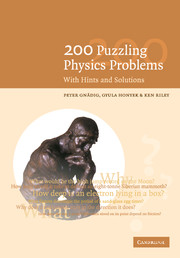Preface
Published online by Cambridge University Press: 05 October 2013
Summary
In our experience, an understanding of the laws of physics is best acquired by applying them to practical problems. Frequently, however, the problems appearing in textbooks can be solved only through long, complex calculations, which tend to be mechanical and boring, and often drudgery for students. Sometimes, even the best of these students, the ones who possess all the necessary skills, may feel that such problems are not attractive enough to them, and the tedious calculations involved do not allow their ‘creativity’ (genius?) to shine through.
This little book aims to demonstrate that not all physics problems are like that, and we hope that you will be intrigued by questions such as:
How is the length of the day related to the side of the road on which traffic travels?
Why are Fosbury floppers more successful than Western rollers?
How far below ground must the water cavity that feeds Old Faithful be?
How high could the tallest mountain on Mars be?
What is the shape of the water bell in an ornamental fountain?
How does the way a pencil falls when stood on its point depend upon friction?
Would a motionless string reaching into the sky be evidence for UFOs?
How does a positron move when dropped in a Faraday cage?
What would be the high-jump record on the Moon?
Why are nocturnal insects fatally attracted to light sources?
How much brighter is sunlight than moonlight?
How quickly does a fire hose unroll?
[…]
- Type
- Chapter
- Information
- 200 Puzzling Physics ProblemsWith Hints and Solutions, pp. vii - ixPublisher: Cambridge University PressPrint publication year: 2001

